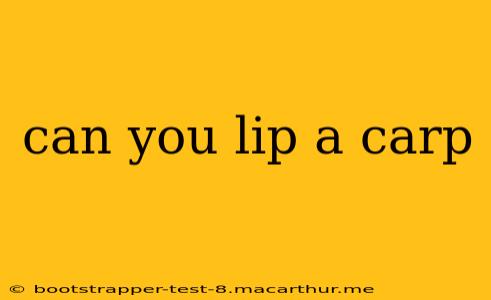Can You Lip a Carp? A Comprehensive Guide to Carp Handling
Carp are powerful and surprisingly agile fish, making their handling a crucial aspect of responsible angling. The question, "Can you lip a carp?" is best answered with a nuanced "it depends." While lipping is a common technique for many fish, its suitability for carp requires careful consideration.
What does "lip a carp" mean?
"Lipping" a fish refers to grasping its lower jaw (the lip) firmly but gently to control and remove it from the water. This method is widely used for various species, offering a relatively safe and effective way to handle fish. However, carp possess unique characteristics that necessitate a modified approach.
Why Lipping Carp Can Be Problematic:
- Sharp Bones in the Mouth: Carp have bony structures in their mouths which can easily puncture your fingers if you're not extremely careful.
- Powerful Jaws: A larger carp can exert considerable force with its jaws, making it difficult to maintain a secure grip. This forceful struggle can cause injuries to both the fish and the angler.
- Risk of Hook Removal Difficulties: Lipping might inadvertently dislodge the hook further into the fish's mouth or make its removal more complicated.
- Damage to the Fish: While the lip might seem like a strong area, forceful gripping can cause internal damage or bruising.
Safer Alternatives to Lipping Carp:
Several methods offer safer alternatives to directly lipping a carp, minimizing the risk of injury to both the angler and the fish:
- Using a Landing Net: This is the most recommended method for carp. A well-sized landing net allows for gentle support and reduces the stress on the fish. It's crucial to have a net large enough to accommodate the carp comfortably.
- Using a Carp Cradle: For larger or more valuable specimens, a carp cradle provides excellent support and prevents damage to the fish while it's out of the water for photographs or weigh-in.
- Supporting the Carp's Body: If using a net isn't feasible, support the fish's body with one hand while carefully removing the hook with another. Always prioritize gentle movements.
How to Properly Handle a Carp (Without Lipping):
- Wet Hands: Always wet your hands before handling a fish to avoid removing their protective slime coat.
- Support the Fish: Use a landing net or support the fish's body carefully to avoid dropping it.
- Remove the Hook: Use long-nosed pliers or forceps to remove the hook as quickly and gently as possible, minimizing stress.
- Return the Fish to the Water: Gently return the carp to the water, ensuring it's able to swim away easily.
What if I Accidentally Lip a Carp?
If you accidentally lip a carp, handle it with extreme caution. Maintain a firm but gentle grip, and prioritize removing the hook swiftly and carefully. Avoid unnecessary force.
Are there any specific circumstances where lipping a carp might be acceptable?
In very specific situations, like quickly removing a deeply hooked fish from dense vegetation to avoid further injury, carefully controlled lipping might be necessary. However, the angler should always favor alternative methods whenever possible. This should only be attempted by experienced anglers who understand the risks.
By employing safer and gentler methods of handling, anglers can contribute to the conservation of carp populations while ensuring their own safety. Prioritizing responsible angling practices ultimately benefits both the environment and the long-term sustainability of this beloved sport.
